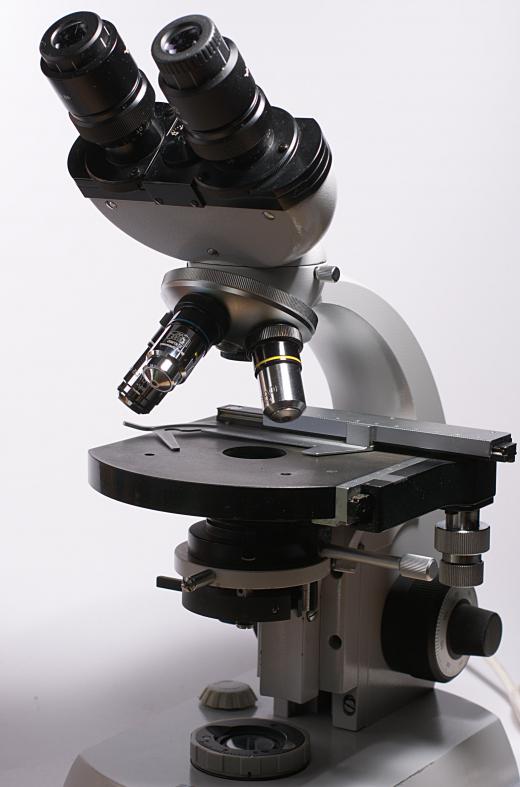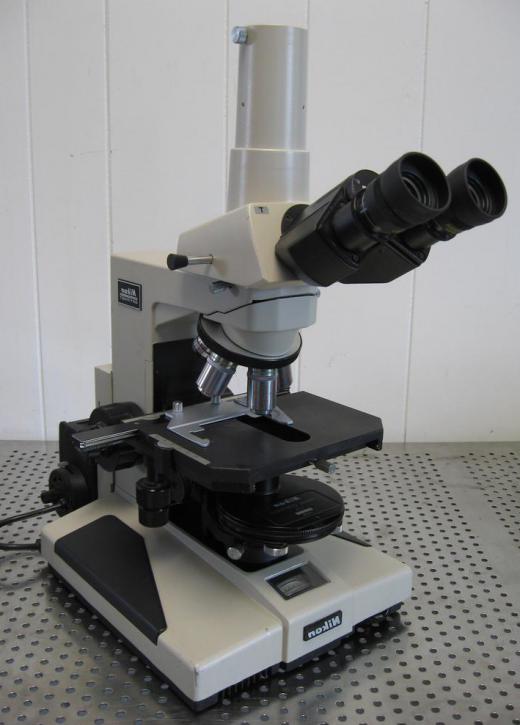What is a Dark Field Microscope?
 Mary McMahon
Mary McMahon
A dark field microscope is a microscope in which the specimen appears bright against a dark background. Dark field microscopy can be used for the purpose of examining a wide range of specimens, from fresh blood cells to live insects. Some microscopes come equipped for the purpose of dark field microscopy, while others can be easily outfitted with the necessary supplies.
When someone uses a dark field microscope, a stop is put between the light source and the condensing lens below the microscope stage, where the specimen sits. The stop blocks the center of the beam of light, allowing light to come in along the sides of the stage only. This light hits the specimen and scatters, passing into the optical lens and meeting the eye of the person using the microscope. Another stop between the stage and the optical lens prevents direct light from reaching the eye, causing the background to appear dark because the user can only see the scattered light from the specimen.

One of the major drawbacks to using a dark field microscope is that it requires high intensity light, because the light levels tend to be low. The extremely bright light can damage some specimens, which is a concern in cases where a specimen cannot easily be replaced. Certain aspects of the specimen may also be obscured in this type of microscope, such as naturally dark features like veins in an insect, and this means that the user could miss some important or interesting details.

The primary advantage to this technique is that it provides high contrast images. For people who have limited access to expensive microscopy equipment, using a dark field microscope can be a low cost alternative which yields useful data for a fraction of the cost. In high school science labs, for example, students may work with dark field microscopes because the school cannot afford expensive high contrast microscopes. It is also sometimes possible to see very small particles which do not show up in some other types of microscopes.
Science stores sometimes sell dark field microscopy kits, which allow people to convert conventional microscopes into dark field microscopes. These kits are designed to be used with microscopes which have slots for filters and attachments. For microscopes which lack these features, a dark field effect can still be achieved by taping a round disc such as a coin or cardboard cutout to the bottom of the condensing lens.
AS FEATURED ON:
AS FEATURED ON:












Discussion Comments
@bythewell - They aren't really that expensive anymore. You can just buy a modern microscope for around $100. It won't be as powerful as, say, the microscopes they use at a university, but it will do the trick.
Then, most modern microscopes can be hooked up to a laptop with an adapter.
And there you go, you are ready to take pictures. If you want to do dark field, then as it says in the article, put a coin over the light, and have fun with it.
Dark field microscopy is particularly good for taking pictures of things that would normally be transparent. This includes a lot of the wildlife you find in pond water.
Dark field microscopes produce some of the most amazing and beautiful macro photographs.
While they don't capture every detail, they light up the subject of the photo with beautiful colors and contrast. A lot of competition winning photographs have been taken using this kind of technique.
There are set ups you can get that allow you to do the same at home, although they can be expensive. It might be worth it though.
Post your comments